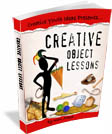Description
Use this creative teaching idea to lead youth in a discussion on priorities and fulfilling the purpose in life for which God placed us in this world.
Materials
- Large sheets of paper or newsprint
- Whiteboard markers (that will not bleed through the paper)
Preparation
-
- Put a Poster or large sheet of paper in each corner of the room for each of the following labels:
- Possessions or provision
- Power or Position
- Popularity
- Others
- Place a chair in the exact center of the room as a marker.
- Put a Poster or large sheet of paper in each corner of the room for each of the following labels:
Explain
- Possessions refer to the material things we seek in life.
- Power refers to positions we want to obtain in life.
- Popularity refers to social recognition and fame that people seek in life.
- Explain that the center of the room represents living for God.
What to do
- Allow youth to brainstorm about the things that people have as priorities in their lives. Examples might be good grades, a good job, a marriage partner, a house, to serve God, to have lots of money, etc.
- Then have youth write the priority on the poster that represents that priority. Some items might fit into more than one category (i.e. good grades might be a priority but the reason could be for popularity or for the purpose of getting a job with more money and a higher position – power.)
- After the posters have been filled with examples of each priority, have youth stand somewhere in the room that reflects their most important priorities in life. (For example, if someone’s priority is to make lots of money they might stand in the possessions corner.)
Scripture Text
Read aloud Matthew 4:1-10
Discussion
- How does this passage relate to the posters in the corners of the room? Which poster represents each of the temptations?
- How did Christ’s understanding of his purpose in life reflect his priorities?
- What are some things that are part of God’s plan for every person’s life?
- How can you discover God’s plan for YOUR life?
- What do you believe is part of God’s purpose for bringing YOU into the world? (You may not know all the details yet, but you might have some ideas.)
- Each of you has positioned yourself in a specific corner of the room based on your own priorities. How can someone in your position move closer to “God’s Purpose” for your life and away from the wrong priorities? What are some of the practical steps you can take that would move you closer to God’s ideal plan for your life?
- Commit to one of the steps you can start this week!
Take it to the Next Level
Jesus was tempted with popularity, power, and possessions (material needs). But because Jesus understood his purpose in the world he did not give into temptation. There is nothing wrong with material possessions, power or popularity. But when they replace God as a priority in our lives they become a problem. In fact, later in Jesus’ ministry we would see him providing for the physical needs of people, he would demonstrate the power of God, and he would be popular. Yet his priority was to do the will of God, to accomplish the purpose for which he had been sent into the world. God has brought each of us into the world for a purpose. The better we understand our purpose, the better we will be able to balance our priorities to fulfill that purpose.
Improving Your Teaching
This type of activity can be used for a variety of active learning lessons. Anytime there are choices to be made, or 2 or more facets of an issue, you can write these on posters and have kids move to that area of the room. The easiest is when there are two choices and youth are asked to move to the left or right of the room depending on whether they agree or disagree with a statement… or whether it is true of them or not. If there are lots of choices, just place them on the walls around the room. It gets the youth physically and mentally involved in the lesson by getting the kids out of their seats and thinking about where they personally stand in relation to a question or issue.
 MORE IDEAS? See “Creative Object Lessons”
MORE IDEAS? See “Creative Object Lessons”
200 page e-book that explains everything you need to know when planning your very own object lessons. It contains 90 fully developed object lesson ideas and another 200 object lesson starter ideas based on Biblical idioms and Names / Descriptions of God.
